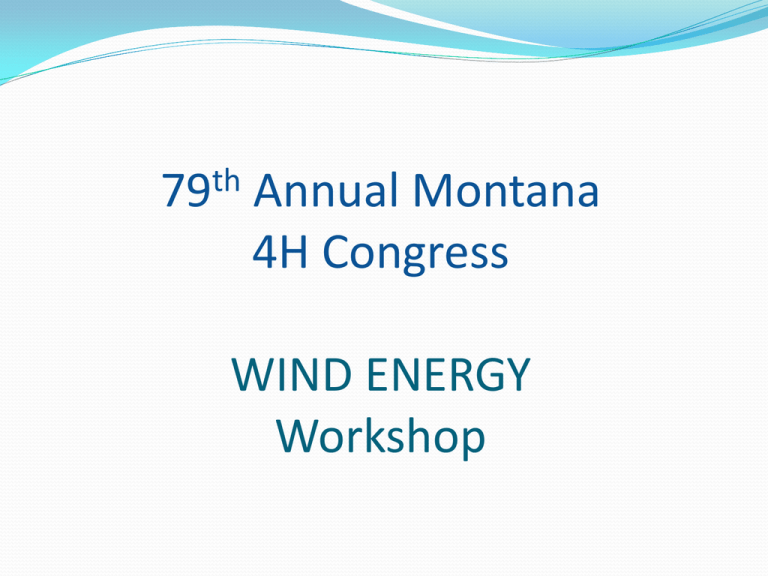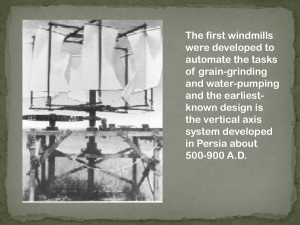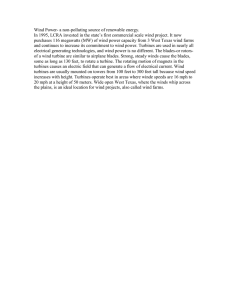What are BIG Turbine Blades made of?
advertisement

th 79 Annual Montana 4H Congress WIND ENERGY Workshop Schedule Wednesday • 1:30- 1:45 Introduction and overview • 1:45 – 2:05 Presentation: Wind Energy • 2:05 – 2:45 Tour of MSU Facilities • 2:45 – 4:00 Wind Turbine Design, Build and Test • 4:00 – 4:30 Wrap-up Schedule Thursday • 10:30- 10:45 Introduction and Overview • 10:45 – 11:05 Social, Environmental and Economic Issues • 11:05 – 12:05 Group Discussions and Debate • 12:05 – 12:20 Share Group Results with Participants • 12:20 – 12:30 Wrap-up Presentation Topics •Energy and Electrical Power Generation •Why Wind? •Wind Turbine Blades – Designs, Aerodynamics, Function •How do we get energy from the air? •Future Trends in Wind ENERGY! Human Power FIRE! ANIMAL POWER FOSSIL ENERGY: COAL, OIL, GAS WATER (HYDRO) ENERGY… NUCLEAR ENERGY… OCEAN ENERGY… SOLAR ENERGY… WIND ENERGY… Wind … • ~0.25% of incident sunlight converted to wind energy • That energy is lost primarily to surface friction and is therefore available to harness Available power ~1W/m2 in surface winds. Global resource estimated to be 30-300 TW. Slide Courtesy of Dr. Angus Rocket, University of Illinois at Urbana-Champaign Some Windmill History Courtesy of Mr. Michael Horneman, Clipper Wind Inc. Wind machines used in Persia in 200 B.C. & in the Roman Empire in 250 A.D. First practical windmills, built in Afghanistan in the 7th century, were vertical axle windmills, with long vertical driveshafts with rectangle shaped blades. Made of 6 to 12 sails covered in cloth, these windmills were used to grind corn and draw up water. 14th century Dutch windmills were in use to drain areas of the Rhine River delta. In Denmark by 1900 there were ~ 2500 windmills for mechanical loads such as pumps and mills, producing an estimated combined peak power of about 30 MW. Some Wind History (continued…) Around the time of World War I, American windmill makers were producing 100,000 farm windmills each year, most for waterpumping. By the 1930s windmills for electricity were common on farms, mostly in the United States where distribution systems had not yet been installed. In this period, high-tensile steel was cheap, and windmills were placed atop prefabricated open steel lattice towers. -A forerunner of modern horizontal-axis wind generators was in service at Yalta, USSR in 1931. This was a 100 kW generator on a 30 m tower. The first windmill for U.S. electricity production was built in Cleveland, Ohio in 1888. By 1908 there were 72 wind-driven electric generators from 5 kW to 25 kW. The largest machines were on 24 m towers with four-bladed 23 m diameter rotors. 2 Installed Wind Capacities („99 – Dec ‟07*) *Preliminary data Drivers for Wind Power Declining Wind Costs Fuel Price Uncertainty Federal and State Policies Economic Development Public Support Green Power Energy Security Carbon Risk Electrical Power Generation Electrical Power Generation Most power used in the world is generated by converting rotational torque into electricity by using copper and magnets. Copper windings When the copper windings pass through the magnetic fields created by the magnets, electrical current is generated and sent to the battery This concept is the basis for most electrical generators, including modern wind turbines. TURNING WIND ENERGY INTO ELECTRICITY ELECTRICAL LOAD (USER) WIND TURBINE BLADES SHAFT & GEARBOX GENERATOR WIRES & DISTRIBUTION SYSTEM (GRID!) Wind is ENERGY Wind is the flow of air or other gases that make up the atmosphere. Air flow is driven by solar heating and earth’s rotation. Since air contains mass (molecules of oxygen, nitrogen, argon, carbon dioxide, etc) and wind possesses velocity (movement) the wind has ENERGY! Much of this ENERGY can be extracted by a wind turbine and turned into electrical energy! So…HOW MUCH ENERGY IS IN THE WIND? E=(.5) (rho) (A) (V)3 That is, ENERGY=(1/2)X(AIR DENSITY)X(SWEPT AREA OF BLADES)X(WINDVELOCITY)3 >> This is the TOTAL energy, but only about 2/3 of it can actually be extracted << Wind Resource Analysis The first step to establishing a potential wind site is to analyze the wind quality The basic tools used for analysis are: Anemometer Direction vane Data logger. Computer modeling software Wind Resource Mapping Wind Turbines and Blades Horizontal Axis Wind Turbines = HAWT From the inside: FAA Lights Nacelle Control Cabinet Blade Generator heat exchanger Gearbox oil cooler Generator Gearbox Pitch Bearing High speed shaft Main Frame (Bed Plate) Hub Yaw drive system (motors) Low speed shaft Yaw Bearing Pitch controller Tower Pitch Drive System HAWT Designs WhalePower http://www.whalepower.com/drupal/?q=node/3 Airbreeze http://airbreeze.com/ Skystream 3.7 Industrial-Scale HAWT Designs Enercon E-126 The World’s Largest Wind Turbine Rotor Diameter 126 meters (413 feet) Rated at 6 MW Hub Height 135 meters (450feet) http://www.newlaunches.com/archives/enercon_e126_worlds_largest_wind_turbine. php VIDEO 1 Vertical Axis Wind Turbines = VAWT Giromill http://www.symscape.com/node/407 Darrieus http://www.symscape.com/node/406 Quietrevolution 5 Windspire http://www.popsci.com/files/imagecache/photoga llery_image/files/articles/mariah-powerwindspire_pg-1.jpg http://www.quietrevolution.co. uk Savonius http://www.symscape.com/blog/vertical_axis_w ind_turbine Turbine Blades Aerodynamics are used to produce lift just like an airplane wing. Blades are light weight but very strong. Fabricating BIG Turbine Blades COMPOSITE MATERIALS = COMBINATIONS OF SEVERAL MATERIALS The main materials for modern turbine and epoxy resin. The fiberglass cloth is laid in large molds while epoxy is injected into the molds under pressure. Static and Dynamic Blade Testing Blades are tested to ensure performance and reliability in the field. http://environmentalresearchweb.org/cws/article/opinion/37719/1/ERWbend_1009_09 Even Rigorous Testing Cannot Prevent Occasional Problems Internal Burn Marks Example: Damage caused by lightning strike to a blade with inadequate grounding. Internal Spar Burned Down the Length VIDEO 2 Inside a turbine… Some Limitations Turbines must be located at the wind resource Transmission: Power lines from resource to load site Durability and Lifespan of turbines Blade design and construction Wind doesn’t blow all the time! How to provide power to users when wind doesn’t blow? Load Balancing, Power Firming, Smart Grid Issues A lot of wind resources are NOT located near transmission lines (black lines on MAP) Wind power and the grid Wind power is generally not produced where it is used: A transmission system is required to bring power to the user. The U.S. Electrical Distribution grid evolved to deliver power primarily from coal, hydro, oil, and natural gas sources - and does not necessarily support wind development. What does the future hold? What does the future hold? Advances in turbine technology will lengthen the lifespan of the machines More power generated by wind means less pollution in the air Environmental Benefits No SOx or NOx No particulates No mercury No CO2 No water used! States with Green Power Programs 20 3 3 11 19 112 27 58 30 4 7 20 6 5 6 5 5 10 3 2 138 5 5 11 1 14 29 5 2 14 17 3 42 49 5 27 14 3 1 29 34 16 1 15 12 2 Green Power Products Available Restructured Electricity Market No Green Power Activity # Source: National Renewable Energy Laboratory (October 2007) Indicates Number of Green Power Products Offered by Utilities and Companies A New Vision For Wind Energy in the U.S. Bush “…We will invest more in … revolutionary and…wind technologies” Obama. "Wind farms are an important part of our ongoing efforts to make the United States more energy independent... “The future ain‟t what it used to be.” - Yogi Berra MSU Wind Applications Center •Wind For Schools •Public Outreach •Anemometer Loan & Installation •Wind Resource Evaluation •Technical Assistance Website: http://www.coe.montana.edu/wind/





